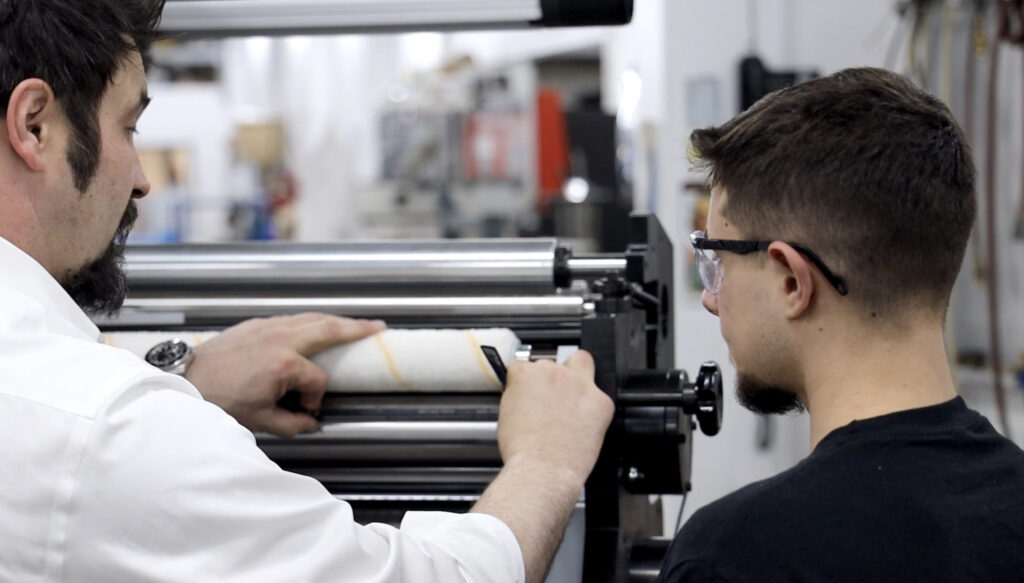Die-cutting is a process used for fabrication in manufacturing that is very versatile and can be customized. This process converts material through cutting, shearing, and forming it into customized designs and shapes. Die-cutting is popular among label and packaging manufacturers.
Rotary Die-Cutting
Three different types of die-cutting processes are used, including laser, flatbed die, and rotary die-cutting. The laser uses a rapid laser cutting machine, the flatbed die uses a press and flatbed die, and the rotary utilizes a cylindrical rotary press and rotary die. The type of die-cutting process needed depends on the application it is used for.
The rotary machine’s settings, the type of rotary die, and the material being used will affect whether the process is at peak capacity and running smoothly.
Rotary Die-Cutting Press Components
This style of die-cutting uses custom cylindrical dies attached to the rotary press that changes the web or other material. The web, individual sheets, or a roll of flexible material, is fed through the die-cutting station, where an anvil cylinder and a cutting die cylinder rotate in opposing directions. The transposable rotary die is where the actual cutting occurs, while the anvil is used as a hard surface alongside it.
As the machine is fed a web or material, it is compressed by the cutting die edge that is against the anvil cylinder while the edge slices through the material. This process delivers precise slits, perforations, or cuts of the material.
To ensure the die cuts are aligned properly and are consistent throughout the material, the rotary machine’s cylinders and web use the same speed setting during the run. To achieve a higher level of consistency and cutting precision, you can opt for servo controls and motors for your machine instead of relying on the rotation of gears.
Considerations for Rotary Die-Cutting Materials
There is a wide array of materials that can be used for rotary die-cutting, such as laminates, paper, foam, plastic, and thin metal. To achieve the best results and how to configure your machine for peak performance will greatly depend on what material is being converted and the material’s properties.
Further, the properties will impact the rotary cutting die design, including the bevel angle and geometry of the cutting edge. The required angle and height for the cutting blade depend on the thickness of the material and how easily it is compressed. If you are cutting materials with multiple layers, it may require a few different blade angles and heights or coating applications.
Using Flexible and Solid Dies
It is important to select the correct type of die for your operation by considering the material and needed specifications, as well as the cost of the investment and turnaround times.
There are two prominent kinds of dies used for rotary presses: flexible dies and solid dies. Flexible dies are typically better for materials that are less coarse and used for shorter runs. Solid dies are better suited for material that is abrasive and with larger production runs.
Flexible die technology does come with a more expensive initial investment than solid dies because of the magnetic cylinders that are used, but it can be more economical in the long term when re-purchasing the budget-friendly flexible die component. In addition, flexible dies are more susceptible to needing to be replaced, even though they are faster to procure. Solid dies are more expensive to manufacture, but this cost can be offset when running bigger quantities because it is less likely to need to be replaced during production runs. Solid dies have the durability to endure numerous cycles of production.
While both types of dies can be used for most kinds of materials, you should consider the advantages versus disadvantages of both for your specific manufacturing applications.
Rotary Die-Cutting Benefits
Rotary die-cutting provides many advantages for manufacturers, including:
- A decrease in lead time
- Reduction of material waste
- Precision cut consistency and uniformity
- Handling high-volume production
- Fast turnaround times
- Decrease in production downtime
You can cut a variety of designs with a rotary die-cutting process, and because the design is engraved into the die, it is easy to produce consistent and uniform parts. Material waste is also decreased due to the high precision of cuts because the designs can be spaced closer together.
Using a rotary die-cutting process can reduce downtime because the dies are easily interchangeable, so there is no need to stop production for long periods. Rotary dies are capable of handling complex designs using a variety of materials with the option of using solid dies for different cutting capabilities.
Tamarack® Products delivers customers with high-quality die-cutting solutions with our converting equipment. We bring more than 50 years of experience and are world-renowned for producing high-precision, top-quality equipment and machinery for web-finishing, in-line window systems, RFID inlay insertion, film patching systems, and more.
Tamarack® Products provides scalable, flexible, customizable converting equipment solutions that include die-cutting, window patching, gluing, and many more. Our knowledgeable team can assist you with the installation, training, and testing of your die-cutting machinery so your business continues to run seamlessly. Contact us to learn more about how we can help improve your converting and die-cutting applications.





